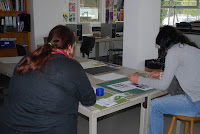 |
| Paige, who will play Anna |
In the film opening our main female character will be present, 'Anna'. Another will be present who will be our ghostly creepy character (which will be the ghost of Anna). The audience will know who the main protagonist is through the use of close ups, we will do this to allow the audience to really connect with Anna, also as she will be the only main character in the scene. There is one binary opposition in terms of Proppian roles, this will be Anna vs her ghost self. This fits in well with the theme of the film as the idea is that she is her own worst enemy, and at war against herself. The audience will know this by the narrative and dialogue between her and her dad. In terms of casting we have an idea for a main character, she is a young dark haired girl with a slight rebel side (left). We want her to wear average teenage attire when she is playing Anna. When she is playing her ghost self we want her to wear a white nightie with bare feet, messy hair and ghostly white make-up. We will film at a friends house. It is an average sized family cottage based in Ombersley, it is exactly how we want it and suits our storyboard. We want the interior of the house to look as if the girl is unpacking and just moved in, we will need props such as boxes. We'd like to create a slightly creepy atmosphere with tense moments and plenty of enigmas. In terms of mise-en-scene we will create an awkward atmosphere and the feeling of a paranormal thing being present through the use of camera shots, angles and close ups. Almost all of the filming is going to be indoors so we have little need to worry about weather. We are going to use the local churchyard for some filming and have asked the church verger, he said this was fine as long as we didn't film any new graves, as this is disrespectful to families. For example, we can't show a grave that was put there this year but can film the ancient graves. We will film just before dusk so the lighting shouldn't be a problem. We will use enigma codes to ensure the audience want to keep watching, we will do this by using shots to give the idea that another person or spirit is present and plenty of unanswered questions. Action codes will be used and by the end of the sequence the audience should feel on edge, tense and interested to find out more, they will know who the main character is and the basic story line. We will use white writing on a black background for our titles with eerie fonts. Smooth transactions mixed with sudden flashes of scene to credit. The information on the titles will be; "Decorus Nex productions presents", "starring Paige Sturgeon", "Filmed, edited and produced by Hannah and Georgia" and any other necessaries entered at a later date.




















